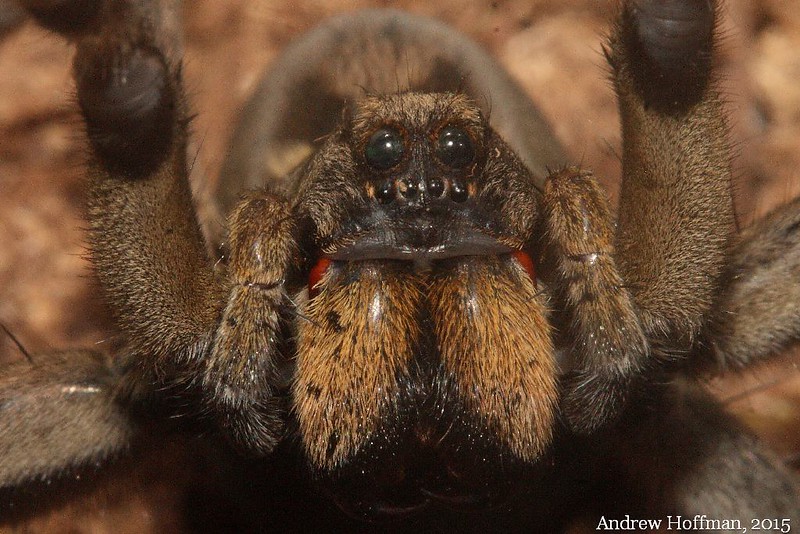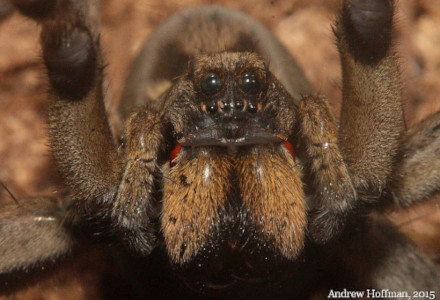
Photographer: Andrew Hoffman
CC License: https://bit.ly/3fZXLun
Carolina Wolf Spider Facts
- Firstly, for someone with arachnophobia, the sheer size and appearance of the Carolina Wolf Spider can be the source of nightmares. This holds true because the amazing arachnid forms the largest of the known wolf spiders in its habitat range.
- Yet, despite its comparatively intimidating appearance, this arachnid remains relatively harmless to humans. But, its large size often causes a bite to be painful to the victim due to the sheer size of the fangs. That fact leads to misconceptions about its toxicity.
- This species also does not usually react aggressively. In point of fact, individuals typically flee from any creature larger than itself. Though daunting in appearance, the Carolina Wolf Spider usually only bites if it feels threatened and cannot flee.
- Though rare in occurrence, envenomings do sometimes occur. Those who experience this typically compare the sensation to the sting of a bee or wasp. In fact, the venom of this arachnid actually remains mostly harmless to any large mammal.
- For the moment, its population appears to be large in number, and relatively stable. The IUCN, therefore, currently has no listing for it. It nevertheless could be considered to be at some risk due to the ongoing effects of climate change, like other species.
Related Articles
Trogloraptor Diving Bell Spider Peacock Spider
Carolina Wolf Spider Physical Description
Perhaps most notably, exceptional specimens of the Carolina Wolf Spider attain a leg span of as much as 4 in (10 cm). A slight degree of sexual dimorphism also presents itself in this species. That occurs because females of the species average about 25% larger than the males.
The remarkable species further most commonly displays a highly useful physical appearance. Individuals generally appear a light gray or light brown in color, with darker patches. Given its environment, this pattern provides the arthropod with natural camouflage.
The body also typically has a covering of small hairs, giving the species a furry appearance. The precise reason for this particular evolutionary adaptation, however, presently remains undetermined. The overall effect creates a daunting visage to those who encounter it.
The eight compound eyes of the Carolina Wolf Spider grow relatively large in comparison to body size. In fact, its eyes develop as so highly reflective that people often hunt it at night. A simple flashlight used to spot the creature clearly highlights these orbs.
- Kingdom: Animalia
- Phylum: Arthropoda
- Class: Arachnida
- Order: Araneae
- Family: Lycosidae
- Genus: Hogna
- Species: H. carolensis
Photographer: Patrick Randall
CC License: https://bit.ly/1iowB8m
Carolina Wolf Spider Distribution, Habitat, and Ecology
The full endemic range of the impressive Carolina Wolf Spider actually covers a relatively large region. That’s despite the common name for it. In point of fact, that range includes Ontario, Canada, and much of the continental United States, including North Carolina.
The species proves itself to be highly versatile and adaptable. Individuals typically reside in shallow burrows. It nevertheless adapts well to different climates. Generally, though, the invertebrate appears in either prairie, glades, open fields, or arid regions, such as deserts.
The lifespan of the physically impressive females of the species averages 2-3 years. The male, however, typically lives less than 1 year, dying shortly after mating. The evolved practice of sexual cannibalism remains the main reason for the difference in lifespans.
In conclusion, like many related species, individuals hunt exclusively as ambush predators. Its diet, therefore, consists primarily of numerous insects native to the region it lives in. But, even small rodents sometimes fall prey to the spiders voracious appetite.
Species Sharing Its Region
Opossum Doll’s Eye Rosy Maple Moth
Check out our other articles on 6 Magnificent Carnivorous Plants, Berca Mud Volcanoes, Fairy Lantern, Black Footed Cat, Goliath Beetle, Pangolin, Philippine Cobra

